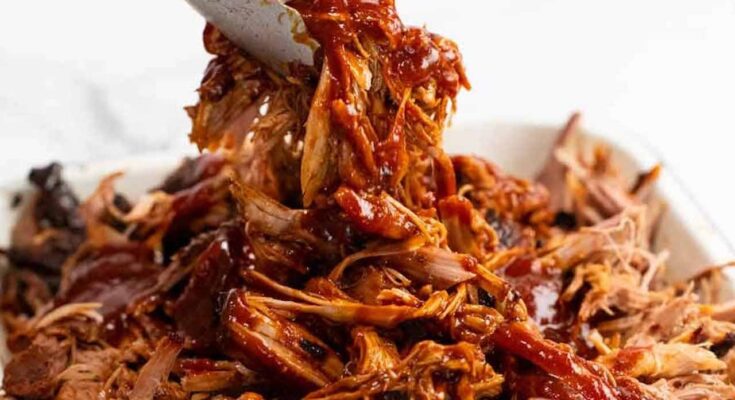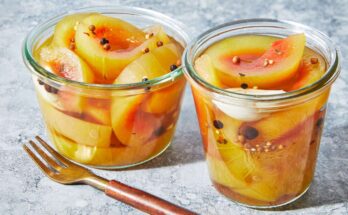Best Pulled Pork Recipe: Pulled pork is a cornerstone of American barbecue, offering a perfect balance of smoky flavor, juicy meat, and tender texture. Whether you’re a beginner or a seasoned pitmaster, mastering this dish can elevate your cooking game.
This guide will walk you through every step, from choosing the right cut to serving up a delicious meal that’ll have everyone asking for seconds.
Why Pulled Pork is a BBQ Classic
Pulled pork holds a special place in the hearts of BBQ lovers. It’s the epitome of comfort food, with its juicy, flavorful strands of pork that are perfect for sandwiches, tacos, or even pizza toppings. The slow cooking process breaks down the fat and connective tissue, transforming a tough cut of meat into something incredibly tender. Plus, it’s a versatile dish that can be customized with different rubs, sauces, and cooking methods, making it a true crowd-pleaser.
Choosing the Right Cut of Pork
Best Cuts for Pulled Pork
For the best results, you need the right cut of meat. The ideal choice is pork shoulder, specifically the Boston butt (upper part of the shoulder) or pork butt. Here’s why:
- Boston Butt (Pork Butt) – This cut comes from the upper part of the pig’s shoulder and has a good balance of fat and connective tissue, which breaks down beautifully when cooked low and slow.
- Pork Shoulder (Picnic Roast) – Slightly leaner than the Boston butt, this cut still has enough fat to produce tender, flavorful pulled pork, but it might require a bit more attention to prevent drying out.
Why Pork Shoulder is the Top Choice
Pork shoulder is perfect for pulled pork because it has a high fat content and plenty of connective tissue. This combination creates the juicy, melt-in-your-mouth texture that makes pulled pork so satisfying. Plus, the shoulder’s rich flavor stands up well to bold seasoning and smoky cooking methods.
Essential Tools and Equipment
Smoker vs. Oven vs. Slow Cooker
Choosing the right cooking method is crucial for achieving the best pulled pork:
- Smoker: Ideal for a deep, authentic BBQ flavor, thanks to the long exposure to wood smoke.
- Oven: Great for those without a smoker, providing consistent heat and easy temperature control.
- Slow Cooker: Convenient and easy, though it lacks the authentic smoky flavor of a smoker.
Meat Thermometer Importance
A meat thermometer is essential for perfectly cooked pulled pork. You’ll want to reach an internal temperature of 195-205°F (90-96°C) to ensure the meat is tender enough to pull apart easily. This is the temperature range where the collagen and connective tissue fully break down, giving you that signature juicy texture.
Key Ingredients for the Best Pulled Pork
Dry Rubs and Marinades
Creating the right flavor profile starts with a good dry rub. Here’s a simple yet effective blend:
- 1/4 cup brown sugar
- 2 tbsp smoked paprika
- 1 tbsp salt
- 1 tbsp black pepper
- 1 tbsp garlic powder
- 1 tbsp onion powder
- 1 tsp cayenne pepper (optional, for a bit of heat)
Mix these ingredients thoroughly and massage them into the pork, ensuring every nook and cranny is covered.
Choosing the Right BBQ Sauce
Whether you like your pulled pork tangy, sweet, or smoky, the right sauce makes all the difference. Some popular choices include:
- Carolina Vinegar Sauce: Tangy and sharp, perfect for cutting through rich pork.
- Memphis BBQ Sauce: Balanced, with a mix of sweetness, tang, and a hint of spice.
- Kansas City BBQ Sauce: Thick, sweet, and smoky – a crowd favorite.
Preparing the Pork
Trimming and Seasoning
Before cooking, trim excess fat from the pork shoulder, but leave a decent fat cap for added flavor and moisture. Apply the dry rub generously, pressing it into the meat to form a flavorful crust as it cooks.
Marinating Tips for Maximum Flavor
For the best flavor, let the seasoned pork rest in the refrigerator for at least 8-12 hours before cooking. This gives the spices time to penetrate the meat, enhancing the overall taste.
Cooking Methods for Pulled Pork
Once your pork shoulder is prepped and seasoned, it’s time to cook. Here are three popular methods, each with its own benefits:
Smoking Low and Slow
Smoking is the traditional method for authentic pulled pork, known for its deep, smoky flavor and beautiful bark. Here’s how to do it:
- Preheat Your Smoker: Set your smoker to 225-250°F (107-121°C). Use hardwood like hickory, apple, or oak for a balanced, smoky taste.
- Place the Pork on the Grill: Put the seasoned pork shoulder on the smoker, fat side up, to allow the fat to naturally baste the meat as it cooks.
- Monitor the Temperature: Use a meat thermometer to track the internal temperature.
- Spritz for Moisture: Every 60-90 minutes, spritz the pork with a mixture of apple juice and apple cider vinegar to keep it moist and enhance the flavor.
- Wrap for the Stall: Around 160°F (71°C), the meat may hit a “stall” where it stops rising in temperature. This is normal. Wrap the pork tightly in aluminum foil or butcher paper to push through this stage.
- Finish and Rest: When the internal temperature reaches 195-205°F (90-96°C), remove the pork from the smoker and let it rest for 30-60 minutes before shredding. This step is crucial for juicy, tender meat.
Oven-Roasting for Indoor Convenience
If you don’t have a smoker, your oven can still deliver amazing pulled pork. Here’s how:
- Preheat the Oven: Set it to 300°F (150°C).
- Prepare a Roasting Pan: Place the pork shoulder in a roasting pan or Dutch oven, fat side up.
- Add Moisture: For extra flavor, add a bit of liquid to the pan, like apple juice, beer, or chicken broth, along with some onions and garlic.
- Cover and Cook: Cover the pork tightly with foil or a lid to lock in moisture.
- Cook Low and Slow: Roast for 4-6 hours, or until the internal temperature hits 195-205°F (90-96°C).
- Rest Before Shredding: Let the meat rest for at least 30 minutes before shredding to allow the juices to redistribute.
Using a Slow Cooker for Set-It-and-Forget-It Ease
The slow cooker is perfect for hands-off cooking, and it still produces delicious pulled pork:
- Prep the Pork: Season the pork as usual and place it in the slow cooker.
- Add Liquid: Pour about 1/2 cup of BBQ sauce, apple juice, or broth over the pork to keep it moist.
- Cook on Low: Set to low for 8-10 hours or high for 4-6 hours, depending on your time frame.
- Check for Tenderness: The pork should be fork-tender and reach the ideal internal temperature.
- Rest and Shred: Remove the pork, let it rest briefly, then shred it with two forks.
How to Know When Your Pulled Pork is Done
Pulled pork is ready when it reaches an internal temperature of 195-205°F (90-96°C). At this point, the connective tissues have broken down completely, making the meat juicy and easy to pull apart. Remember to let it rest for at least 30 minutes after cooking to lock in all those flavorful juices.
Shredding and Serving Pulled Pork
The Right Way to Shred
Once your pork has rested, it’s time to shred. Here’s the best way to do it:
- Use Two Forks: Simply pull the meat apart with two forks, separating it into long, juicy strands.
- Meat Claws (Optional): If you’re a BBQ enthusiast, meat claws make quick work of shredding and add a bit of fun to the process.
- Mix in the Juices: Toss the shredded pork in its own juices or a bit of BBQ sauce for added flavor and moisture.
Best Buns and Toppings
Choosing the right bun and toppings can take your pulled pork sandwich to the next level:
- Buns: Brioche, potato rolls, or classic hamburger buns work great.
- Toppings: Coleslaw, pickles, onions, and a drizzle of your favorite BBQ sauce are traditional choices.
- Sides: Serve with baked beans, cornbread, or potato salad for a full BBQ experience.
Storing and Reheating Leftovers
Pulled pork stores well, making it great for meal prep:
- Refrigerate: Store in an airtight container in the fridge for up to 4 days.
- Freeze: Pulled pork freezes beautifully. Just pack it in freezer-safe bags or containers, and it will keep for 3-4 months.
- Reheat Gently: For best results, reheat slowly in a covered dish with a splash of broth or BBQ sauce to keep it moist.
FAQs about the Best Pulled Pork Recipe
1. What is the best cut of meat for pulled pork?
The most popular choice is pork shoulder (also known as pork butt or Boston butt) because of its high fat content and marbling, which makes the meat tender and flavorful when slow-cooked.
2. How long should I cook pulled pork?
Typically, pulled pork needs 8-10 hours on low in a slow cooker, 6-8 hours in a smoker, or 4-5 hours in the oven, depending on the cut size and cooking method.
3. What is the secret to juicy pulled pork?
Low and slow cooking, a good dry rub, and adding a bit of liquid (like apple cider vinegar or broth) can help keep the meat moist and flavorful.
4. Can I make pulled pork in advance?
Yes! Pulled pork tastes even better the next day as the flavors have more time to meld. Store it in an airtight container in the refrigerator for up to 4 days or freeze for longer storage.
5. What can I serve with pulled pork?
Classic sides include coleslaw, cornbread, baked beans, and pickles, but it also pairs well with fresh salads, mac and cheese, or roasted vegetables.
Conclusion
Pulled pork is a barbecue staple for a reason. Its rich, smoky flavor and juicy texture make it a hit at any gathering. Whether you smoke it, roast it, or slow-cook it, this guide gives you all the tools you need to master the art of pulled pork. Remember to use the right cut, season generously, and cook low and slow for the best results.



